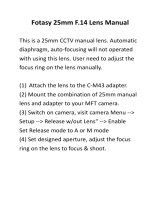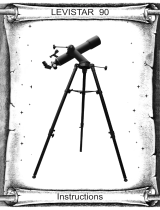
19
Series 2 – #94119-20
Deep Yellow, Red, Light Green, ND25% T (#s 12, 25, 56, 96ND-25)
Series 3 – #94119-30
Light Red, Blue, Green, ND50% T (#s 23A, 38A, 58, 96ND-50)
Series 4 – #94119-40
Yellow, Deep Yellow, Violet, Pale Blue (#s 8, 47, 82A, ND96-13)
Light Pollution Reduction (LPR) Filters - These filters are designed to enhance your views of deep sky astronomical
objects when viewed from urban areas. LPR Filters selectively reduce the transmission of certain wavelengths of light,
specifically those produced by artificial lights. This includes mercury and high and low pressure sodium vapor lights. In
addition, they also block unwanted natural light (sky glow) caused by neutral oxygen emission in our atmosphere. Celestron
offers a model for 1-1/4" eyepieces (#94123) and a 2" eyepieces.(#94124).
Micro Guide Eyepiece (#94171) - This multipurpose 12.5mm illuminated reticle can be used for
guiding deep-sky astrophotos, measuring position angles, angular separations, and more. The laser
etched reticle provides razor sharp lines and the variable brightness illuminator is completely
cordless. The micro guide eyepiece produces 163 power with the C8 and 188 power with the C9.25.
Polarizing Filter Set (#93608) - The polarizing filter set limits the transmission of light to a
specific plane, thus increasing contrast between various objects. This is used primarily for
terrestrial, lunar and planetary observing.
Radial Guider (#94176) - The Celestron Radial Guider
®
is specifically designed for use in prime focus, deep sky
astrophotography and takes the place of the T-Adapter. This device allows you to photograph and guide simultaneously
through the optical tube assembly of your telescope. This type of guiding produces the best results since what you see
through the guiding eyepiece is exactly reproduced on the processed film. The Radial Guider is a “T”-shaped assembly that
attaches to the rear cell of the telescope. As light from the telescope enters the guider, most passes straight through to the
camera. A small portion, however, is diverted by a prism at an adjustable angle up to the guiding eyepiece. This guider has
two features not found on other off-axis guiders; first, the prism and eyepiece housing rotate independently of the camera
orientation making the acquisition of a guide star quite easy. Second, the prism angle is tunable allowing you to look at guide
stars on-axis. This accessory works especially well with the Reducer/Corrector.
Skylight Filter (#93621) - The Skylight Filter is used on the Celestron telescope as a dust seal. The filter threads onto the
rear cell of your telescope. All other accessories, both visual and photographic (with the exception of Barlow lenses), thread
onto the skylight filter. The light loss caused by this filter is minimal
.
Solar Filter - The Baader AstroSolar® filter is a safe and durable filter that covers the front opening of the telescope. View
sunspots and other solar features using this double-sided metal coated filter for uniform density and good color balance across
the entire field. The Sun offers constant changes and will keep your observing interesting and fun. C8 - #94128, C11 -
#94238.
T-Adapter - T-Adapter (with additional T-Ring) allows you to attach your SLR camera to the rear cell of your Celestron
telescope. This turns your telescope into a high power telephoto lens perfect for terrestrial photography and short exposure
lunar and filtered solar photography. #93644 for the 8" and #93646 for the 9/11/14" optical tubes.
T-Ring - The T-Ring couples your 35mm SLR camera body to the T-Adapter, radial guider, or tele-extender. This accessory
is mandatory if you want to do photography through the telescope. Each camera make (i.e., Minolta, Nikon, Pentax, etc.) has
its own unique mount and therefore, its own T-Ring. Celestron has 8 different models for 35mm cameras.
A full description of all Celestron accessories can be found in the Celestron Accessory Catalog (#93685)





















